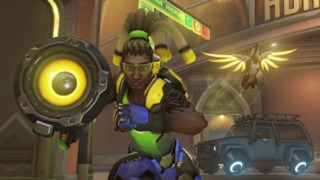An Intermediate Guide to Supports, Part 1: Lucio and Mercy
By Cav829 17 Comments

So you want to play Supports in Overwatch? Excellent choice! You’re in for a wild ride filled flankers diving you while your teammates are too busy shooting into Reinhardt’s shield, salty DPS players upset you stole their Play of the Game, and most importantly, being blamed for every single last thing that goes wrong. Support play is the backbone of every team in Overwatch. At any game above Gold level play, at least two of your six player slots need to be devoted to supports to have a reasonable shot of winning. Unlike in many MOBAs, Overwatch’s Supports are actually really fun to play. I primarily play Supports and have been coaching some friends lately and it gave me the idea to write something a little more tuned to the intermediate level of play regarding the role. There are a lot of good basic guides and a some more advanced guides that get into formations and such, but I wanted to write something more focused on getting you from say Gold-level Support play to Platinum.
Rather than trying to squeeze everything into one blog post, I’m going to break this into three parts: Introduction and Core Healers (Mercy and Lucio), DPS/Support hybrids (Zenyatta and Ana), and finally, Symmetra (for you psychopaths still trying to make her work) and a guide on team composition and for non-Support players to better understand how the role works and how to work with your Supports.
Introduction
Let’s start with some figures:
Character | Healing Primary | Healing (other) |
Mercy | 60 (per second) | |
Lucio | 12.5 (per second) | 40 (per second when boosted) |
Zenyatta | 30 (per second) | |
Ana | 70 (per shot, 1.2 shots/second) | 100 (also doubles health from other sources) |
Symmetra | Lol What’s Healing? | 25 Shields |
Now here’s another figure: Mercy’s DPS, which is 100. That’s right: Mercy’s pistol, which most players only break out in emergencies, actually has more per second value the healing any Support provides. Settle down: I’m not telling you all to break out your Battle Mercys. Rather, I want you to understand a very basic concept about Support play in Overwatch: healing is meant to give teammates an advantage in a fight, not make them invincible. You will die under focus fire, even if multiple supports are trying to heal you. This is why if you play Roadhog, stand in the middle of the road while being double healed, and try to tank half the enemy team, you’re still going to die. Also, you’re responsible for your Supports getting wiped out shortly thereafter by the Ultimate you just gave to the other team. Also, you're going to blame me afterward, so screw you in advance!. Healing might be the lynchpin of Support play, but it’s really only where it begins. It also leads to a lot of misunderstandings regarding how to best play Supports, which is why each guide will be tailored to the character rather than giving a lot of general advice.
Lucio
Lucio is the most selected character in both Quick Play and Competitive on almost every platform. Since ELeague play begun, he has been a top 3 pick pretty much every week, sometimes appearing in every team. Lucio is as bread and butter a character as you get in Overwatch. While mechanically simple, higher level Lucio play requires more game sense than possibly any other character in the game. Lucio players are the generals of pro teams. They’re the shot callers.
What is Lucio’s most important ability? If you just said his healing, you’re wrong. Lucio’s primary purpose is to dictate the pace of his battle through his speed boost. Most players learn Lucio the wrong way because the only Gold Medal you’re likely to see as him is total healing. If you’ve heard of the concept of “trash damage,” Lucio can be the king of “trash healing.” Support play is about keeping your teammates alive, not padding your healing stat.

Lucio heals a mere 12.5 HP/second. That means it takes Lucio two seconds to give a teammate enough health to survive one Mercy pistol shot. He’s a pretty terrible healer when it comes to keeping a specific target alive. Many players observe, but often don’t process this when they try to heal 450 HP on a tank, which takes a full 36 seconds minus Amp It Up. Amp It Up boosts his healing to 40 HP/second for three second. That means over 3 seconds of Amp It Up, Lucio will heal more than he will over the 9 seconds he isn’t using it. On the flipside, Lucio’s speed boost offers a 30% increase in movement speed to his teammates and a 70% boost during Amp It Up. To understand how significant an ability this is, an amped Roadhog has faster movement speed than a Genji without speed boost.
The idea you want to ultimately grasp is that while other Supports save teammates through healing, Lucio saves teammates by pulling them out of bad situations before they need as much healing. Typically, you want to get to the point where you use speed boost to initiate combat, position your team, rescue teammates from bad situations, chase down stragglers attempting to escape, and break off engagements. You primarily use healing when Amp It Up is available and during pitched battles where faster movement is less important. Most importantly, you need to learn proper management of Amp It Up, because that twelve second cooldown is an eternity in the middle of a team battle. Proper use of amped speed boosting will actually save just as many teammates from enemy Ultimates as Sound Barrier can.
The advice I have given to better learn Lucio is to stay on speed boost whenever Amp It Up isn’t available to healing when Amp it Up is available. Now this isn’t actually how you’re going to eventually play him, but to improve your game sense on when to use each, you need to really observe in game the moment to moment ways speed boost helps your team.
Further in support of this role is Lucio’s Soundwave, which pushes opponents in the direction you point it at. It is less an ability focused on damage and more about sending opponents into traps and toward or away from your teammates based on the situation. Yes, it’s also the ability used for “knock half the team off the edge” moments on certain maps, but don’t force those types of plays.
Lucio’s Ultimate is fairly straight forward in function: it provides a barrier worth 500 points for your teammates over a six second period, but drains by 100 points per second. Timing its activation is more important than the majority of Ultimates because of this. When you operate in tandem with a Zenyatta, it’s best to have a plan in advance for who will activate their Ultimate when because activating either ability is typically a split-second decision. Sound Barrier is effective against burst damage Ultimates such as Tracer’s Pulse Bomb and increases the time it takes High Noon to lock on while Transcendence is ineffective against these attacks (except for Zenyatta himself). Sound Barrier can even counter a Rip Tire if timed properly, though it isn’t enough to protect most teammates from D.VA’s Self-Destruct. Much like Transcendence, it’s an ability that works best as an Ultimate counter, though can be used to initiate a group battle if timed properly.
Finally, let’s briefly discuss Lucio’s Sonic Projectiles. Lucio has the worst DPS in the game next to Winston and Mei. Never attempt to take on anything in this game one-on-one except maybe an unsuspecting Mercy who doesn’t remember she has a pistol (a good Mercy will often beat you one-on-one). Think of Lucio’s offense as support fire. His projectiles need to be led against smaller targets, so it’s more effective to concentrate on focus firing down tanks and slower characters.
Mercy
Mercy is the spiritual descendant of the Medic from Team Fortress 2.She might be the easiest character in the game to pick up and play. There might not be another character that has the mental impact on an opposing team that a Mercy does. More than any other support, the other team wants you dead because of your Ultimate. Teams often will change their entire comp just to dive your team’s back lines to take you out. I hope you feel honored.
There’s not a whole lot to talk about her basic play because she’s meant to be so mechanically simple. You switch between healing and amping as needed and you pocket your squishier backline DPS characters like McCree if you can. So what goes into advanced Mercy play? In my opinion, there are three key elements: positioning, proper use of Resurrects, and knowing when to break out your Blaster.
Here’s the dilemma of the Mercy player: you have to stay connected to your team in order to heal them, thus you are limited as to where you can position yourself. But if you stay in any particular spot for too long, it makes you a lot easier to flank or dive on. Guardian Angel lets you bounce like a pinball from teammate to teammate, and constant repositioning will make it a lot more difficult for flankers to line up runs on you. This is particularly useful against Genji, who will struggle to burst kill a good Mercy as opposed to a more stationary Zenyatta. It’s also useful against Reaper, who takes longer to set up his flanking routes. I'm not letting you DPS scumbags who don't want to protect us Supports off the hook, but you do have to do your part while playing Mercy to foiling flankers and divers.
Positioning ties right in with her Ultimate ability: Resurrect. While simple to perform, there is a lot of strategy surrounding proper usage of the ability. Too many players will sit on a resurrect hoping to bring back more than one or two teammates thinking it provides “more value.” Too many players want to set up a “Huge Rez” even though it takes a great deal of planning to create those opportunities. And setting up those “Huge Rez” opportunities requires Mercy to actually choose moments to go hide rather than heal, which is a counter-intuitive mindset to get into.
Basically, you want to use Resurrect to salvage a team fight whether that be resurrecting one or five teammates. Mercy’s Ultimate is one of the fastest to charge in the game. Don’t feel you have to always save it for those Play of the Game moments. Wait too long, and anyone you bring back is likely to be put in a six versus two or three situation, which really isn’t of much help. The only real way to learn what those right moments are is to play a lot of matches and develop a good game sense about it.
“Huge Rez” opportunities typically require setup. Basically, if you know the other team is about to hammer your team with Ultimates, Mercy needs to hide and the rest of the team needs to group up. Then, after the team has been wiped, Mercy flies in, pulls off the “Huge Rez,” and thus it nullifies all the resources the other team just put into that battle. These types of situations rarely present themselves by chance.

So here’s where I talk about Battle Mercy. Don’t get too excited: this isn’t giving you the justification to try to earn Gold in eliminations. With that being said, there are a lot more situations than most think to take advantage of the Caduceus Blaster. Mercy’s 100 DPS is actually fairly middle of the pack for the cast. If players hit 100% of their shots, a teammate would have to do over 330 DPS to do more with the amp than Mercy could with her pistol, which is a figure only Bastion reaches without factoring in criticals. The pistol is also fairly easy to aim, making it very effective at close and medium ranges.
I’m not saying you should always use your Blaster over amping teammates. But for instance, what if you and the opposing team are in a pitched battle behind Reinhardt shields? If the other team isn’t flanking you and making you worry about heals, is there really any reason to amp your McCree for less value than firing away? On the other hand, if your McCree is trying to pick off a pesky Pharah, giving him a boost is a little more useful.
Besides the obvious case of self-defense, there’s one other case where Battle Mercy is underrated, and it goes back to positioning. Often times you’ll be in a situation where you’re a little out of range of a teammate being attacked, but flying to them exposes you to danger. In these cases, it might be better to break out the Blaster and try to eliminate the enemy rather than potentially risking yourself trying to get to healing range. I hate to say this in a way that makes it sound selfish, but if there’s one character who has to have a selfish mindset about staying alive, it’s Mercy. Do keep in mind, on PC it’s a lot easier to switch weapons with a flick of the mouse wheel than having to reach down to the D-pad on console.
That’s it for today. Hopefully this was of some help. If you have any comments, questions, or just want to complain about the fact I just convinced your friends to play Battle Mercy, feel free to leave a comment.
